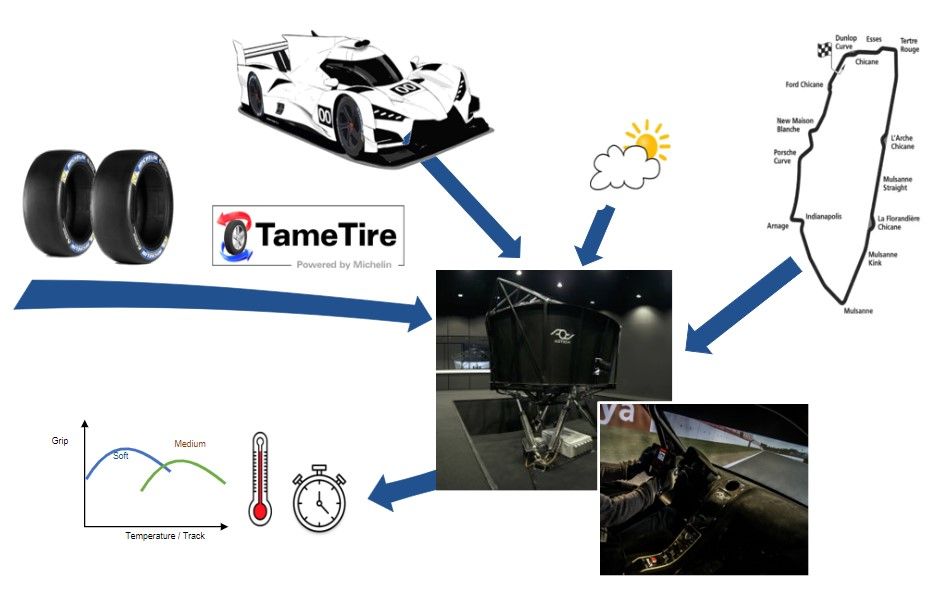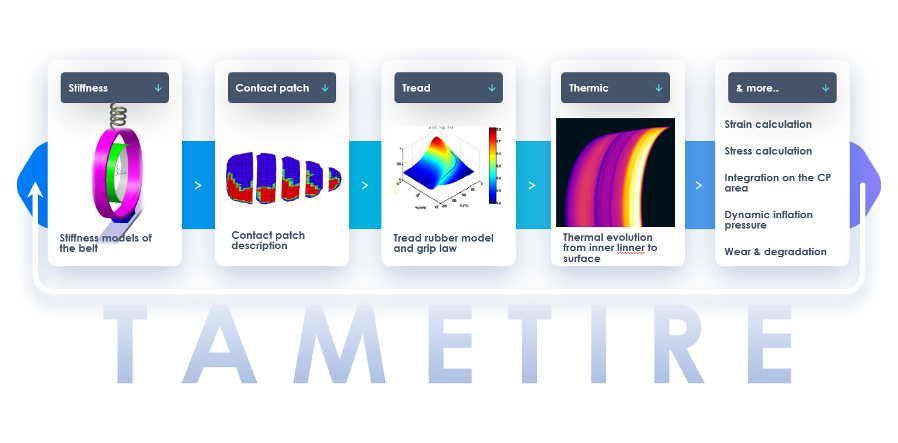TameTire
Michelin research and development

TameTire is a physical tire model that has been developed by Michelin R&D, especially for vehicle dynamic simulations. The model aims to provide accurate description of the transient mechanical and thermal behavior of a tire. It calculates the forces and moments acting on the tire under pure and combined slip conditions and according to the tire operating conditions: vertical load (or rolling radius), inflation pressure, slip angle, slip ratio, camber angle, speed and temperature. Specific numerical algorithms have been developed to have a very fast integration of the mechanical and thermal states of the tire. Therefore TameTire can be used for full vehicle dynamic simulation within off-line simulation environments as well as within driver/hardware in the loop environments.
predict the tire and the vehicle performance
By predicting the tire behavior more physically, vehicle dynamic simulation using TameTire becomes more relevant. Influence of chassis set-up, suspension design and electronic system design can be predicted with better accuracy. Moreover, it is a powerful model to predict the tire and the vehicle performance for any type of manoeuvres, circuit designs and track properties, as far as the tire operating conditions and more especially the tire temperatures are strongly dependent on these properties. So far, TameTire can be used for a wide range of passenger car tire sizes and tire lines and brings improvements and new opportunities in vehicle dynamic simulation for passenger car.

The rubber compound and driving conditions
The main benefit of TameTire compared to mathematical fit models such as Magic Formula, is the capability to extrapolate tire force and moment to the actual driving conditions of the vehicle. The ability to predict tire characteristics that are relevant to the actual driving conditions seen by the tire and the vehicle combined remains an important means of improving tire designs for handling and vehicle dynamics. Many test results show how tire force and moment characteristics are dependent on the test conditions under which they are obtained. This is mainly due to thermal effects and thermo-dependent elastic and viscous properties of the rubber compound.
The current state of the art for handling tire modelling is based on mathematical formulas fitted to indoor test machine measurements. They can represent the tire characteristics for a wide variety of tire lines and sizes. But the forces and moments they describe are only representative of the measurement conditions and the quality of the model prediction is completely linked to the measurement protocol. Improvements on the measurement protocol have been carried out to make the tire thermal states as close as possible to the situations encountered on-track by the tires. However, because indoor tests cannot cover all the actual driving conditions, such an approach disregarding the influence of thermal effects remains limited to few vehicle manoeuvres.


New features
Thanks to the integration of the tire temperatures and the full coupling with the rubber properties, TameTire can be used over a wider range of tire operating conditions than mathematical models and therefore brings new possibilities in vehicle dynamic simulations. Some examples of applications are given below
force and moment predictions
In addition to these new features, force and moment predictions have been improved compared to the current state of the art models